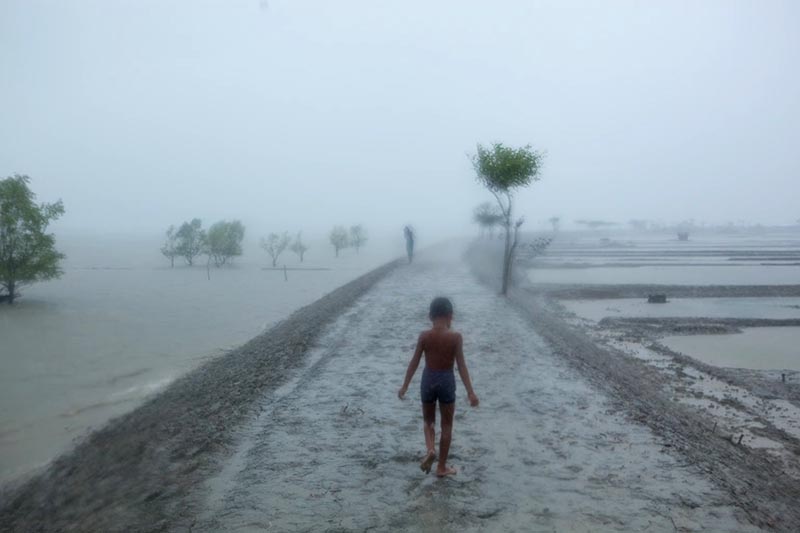Heavy rainfall during the rainy season can have significant repercussions on shrimp production in traditional grow-out ponds, both directly and indirectly affecting various aspects of shrimp health and pond ecology. In this detailed analysis, we will delve into the intricate relationship between heavy rains and shrimp farming, examining how these effects are interconnected and exploring strategies for shrimp farmers to mitigate losses associated with this climatic phenomenon.
The Devastating Impact of Heavy Rains on the Shrimp Sector:
While heavy rains are a natural occurrence, their effects on the shrimp farming industry can be devastating. Despite the severity of these impacts, it is often challenging to attribute subsequent mortalities solely to this climatic factor. Across the South Pacific region, reports indicate that farmed shrimp mortalities can range from 3 to 50 percent of cultured populations within just three to four days of intense rainfall events.
Compounding the problem is the subtle nature of indicators signaling imminent mortality. In many cases, there are minimal signs of atypical shrimp behavior or other typical precursors of production problems. Instead, a pattern of chronic mortality emerges, often undetectable solely through observations of food consumption.
Understanding the Direct and Indirect Effects of Rainfall:
Direct Effects: Heavy rainfall brings about immediate changes in the physical and chemical composition of shrimp ponds. Rainwater, typically cooler and more acidic than pond water, lowers the temperature and pH levels of the ponds. Additionally, dilution reduces salinity and hardness, while suspended solids transported from pond levies increase turbidity, hindering sunlight penetration and disrupting phototrophic populations.
Indirect Effects: The aftermath of heavy rainfall sets off a chain reaction within the pond ecosystem. A rapid decline in microalgae populations occurs due to factors such as pH fluctuations, reduced mineral concentrations, increased turbidity, and diminished solar intensity. This decline paves the way for exponential growth in populations of heterotrophic bacteria, fueled by nutrients from decaying algae cells.
As bacterial populations proliferate, oxygen levels in the water plummet, leading to anoxic conditions. Bacterial respiration further exacerbates the situation by producing carbon dioxide, which dissolves in water, further lowering pH levels. These conditions create an ideal environment for the proliferation of pathogenic bacteria, such as Vibrios spp., posing a significant threat to shrimp health.
| Parameter | Rainfall effects |
|---|---|
| pH | It initially drops to 6.7 and more afterwards |
| Turbidity | Increases due to clay particles |
| Temperature | Usually decreases by 3 to 5 degrees-Celsius |
| Dissolved oxygen | Initially increases, then decreases noticeably |
| Hardness | Decreases depending on volume |
| Salinity | Decreases depending on volume |
| Hydrogen sulfide (H2S) and ammonia (NH3) | Can increase after 2 to 3 days |
Understanding the Impact on Shrimp Health:
Temperature: Shrimp metabolism is highly sensitive to environmental temperature fluctuations. Heavy rains can cause a significant drop in pond water temperature, leading to a temporary reduction in feed consumption. Furthermore, the formation of a cold layer of fresh water under warmer pond water exacerbates thermal stratification, prompting shrimp to migrate to warmer, deeper areas where oxygen levels are lower and H2S concentrations are higher.
Acidity (pH): Rainfall-induced decreases in pH can trigger abrupt die-offs of phytoplankton populations, releasing organic matter that fuels bacterial growth. This process consumes dissolved oxygen, leading to further declines in pH and exacerbating the adverse conditions for shrimp.
Dissolved Oxygen: Dissolved oxygen levels are crucial for shrimp survival, yet heavy rainfall can lead to dangerously low levels due to increased biological oxygen demand by bacteria. Without additional mechanical aeration, dissolved oxygen levels can plummet rapidly, posing a threat to shrimp health and potentially leading to the production of toxic H2S.
Salinity and Hardness: While shrimp mortality directly attributable to salinity is rare, decreases in salinity can disrupt homeostasis, leading to increased susceptibility to secondary infections and mortality. The post-molting phase, reliant on calcium and magnesium ions for exoskeleton hardening, is particularly vulnerable to disruptions in salinity levels.
Wind and Wave Action: Wind-induced wave action can exacerbate erosion along pond levies, leading to increased turbidity and reduced sunlight penetration. Additionally, turbulence associated with wave action can disrupt the aerobic microlayer on pond bottoms, potentially releasing toxic compounds into the water column.
Recommended Practices for Mitigating Rainfall Impact on shrimp farm:
Before the Rains:
- Enhance drainage systems and reinforce pond levies to minimize flooding.
- Employ calcium carbonate applications to maintain pH and hardness levels.
- Implement erosion control measures and ensure proper pond drainage.
During the Rains:
- Monitor water quality parameters closely and adjust feeding practices accordingly.
- Maintain mechanical aeration to ensure adequate oxygen levels.
- Monitor microalgae populations and take preventative measures to mitigate die-offs.
After the Rains:
- Gradually increase feeding as conditions improve, supplementing with essential nutrients.
- Consider probiotic supplementation to support microbial balance in the pond.
- Continue high levels of aeration until a stable microalgae population is established.
In Conclusion:
The impact of heavy rains on shrimp farming is multifaceted, affecting water quality, shrimp health, and overall productivity. By understanding the complex interactions between rainfall and pond ecosystems and implementing proactive management strategies, shrimp farmers can minimize losses and maintain sustainable farming practices in the face of changing climatic conditions.
